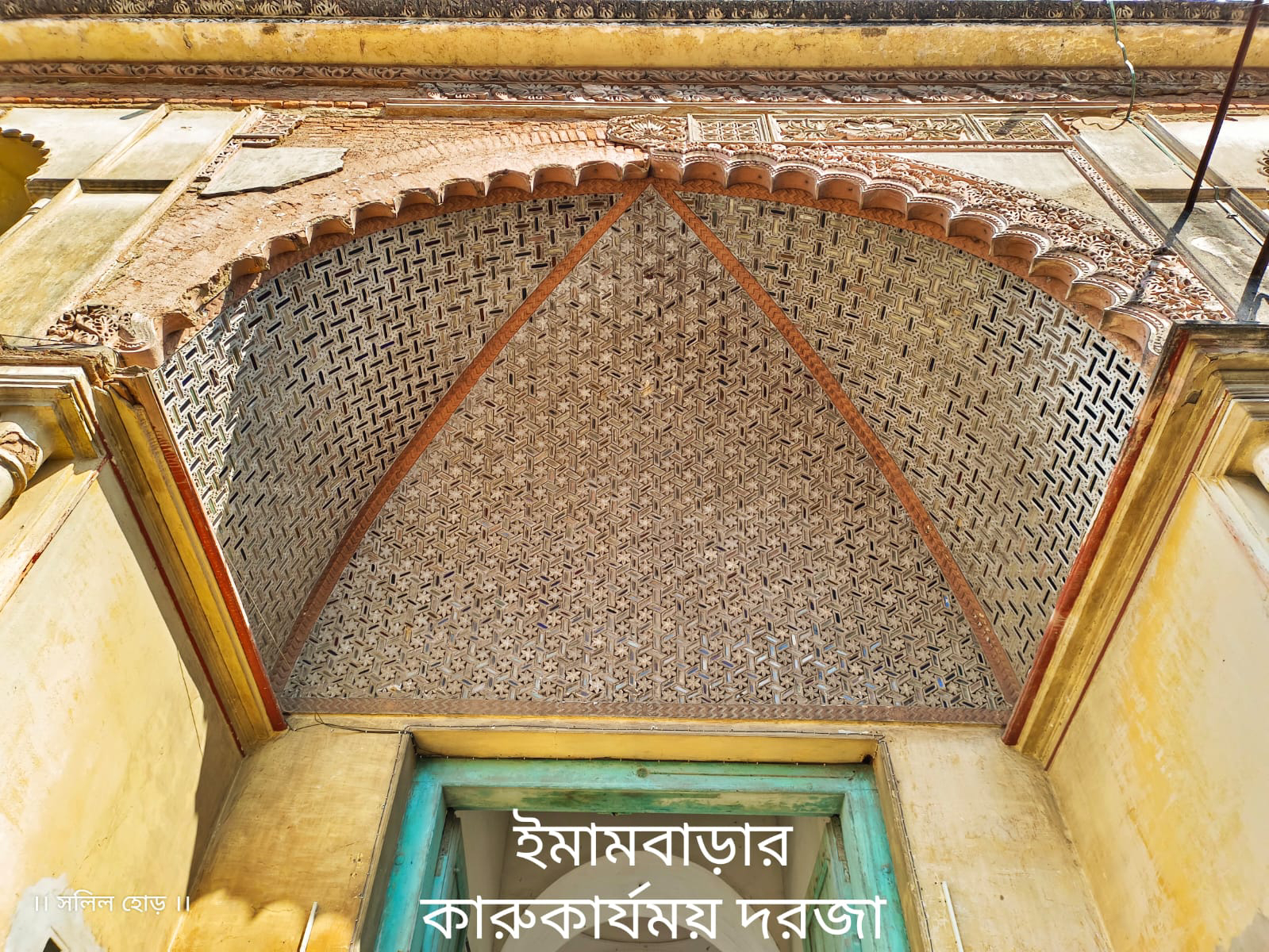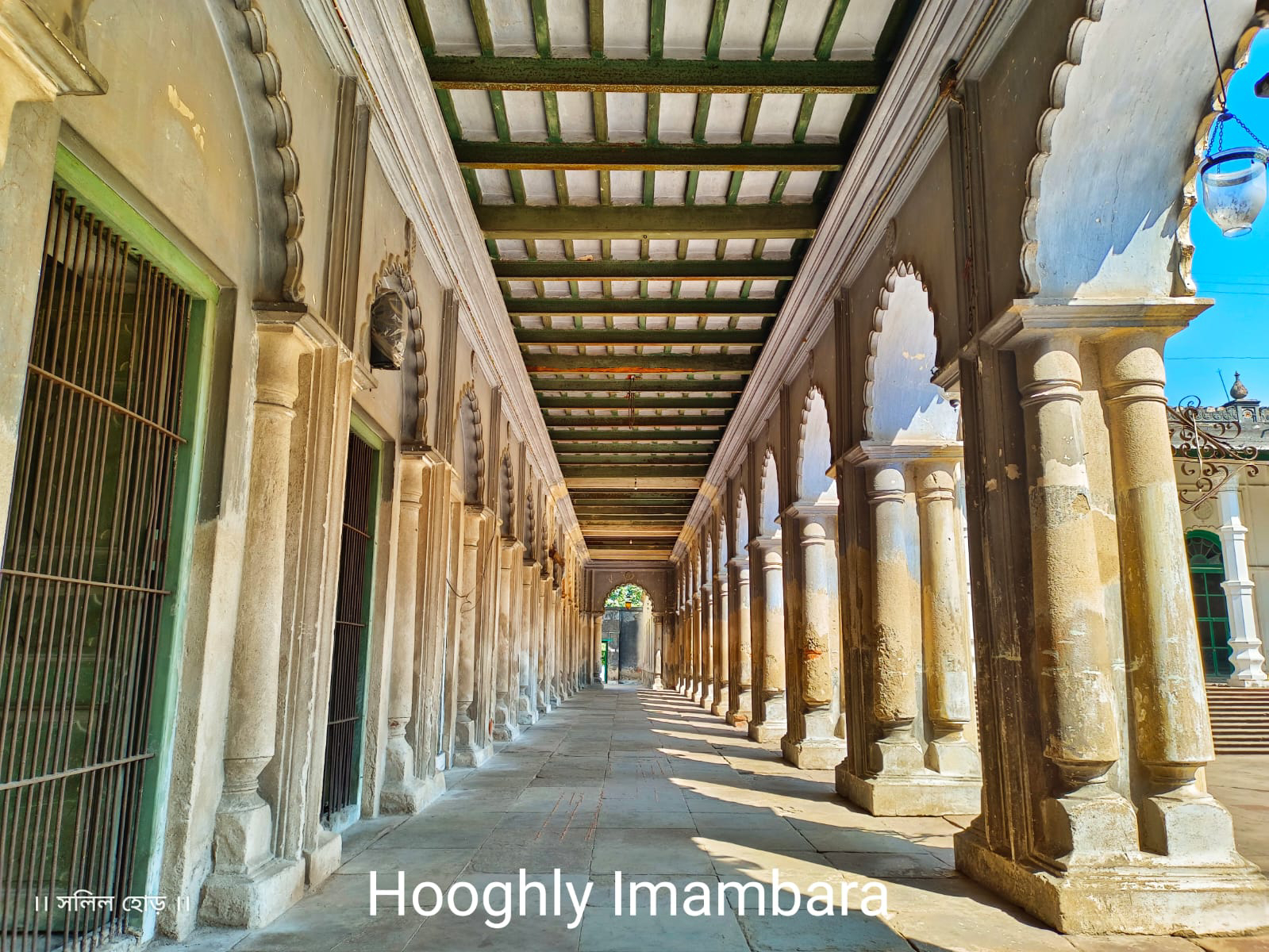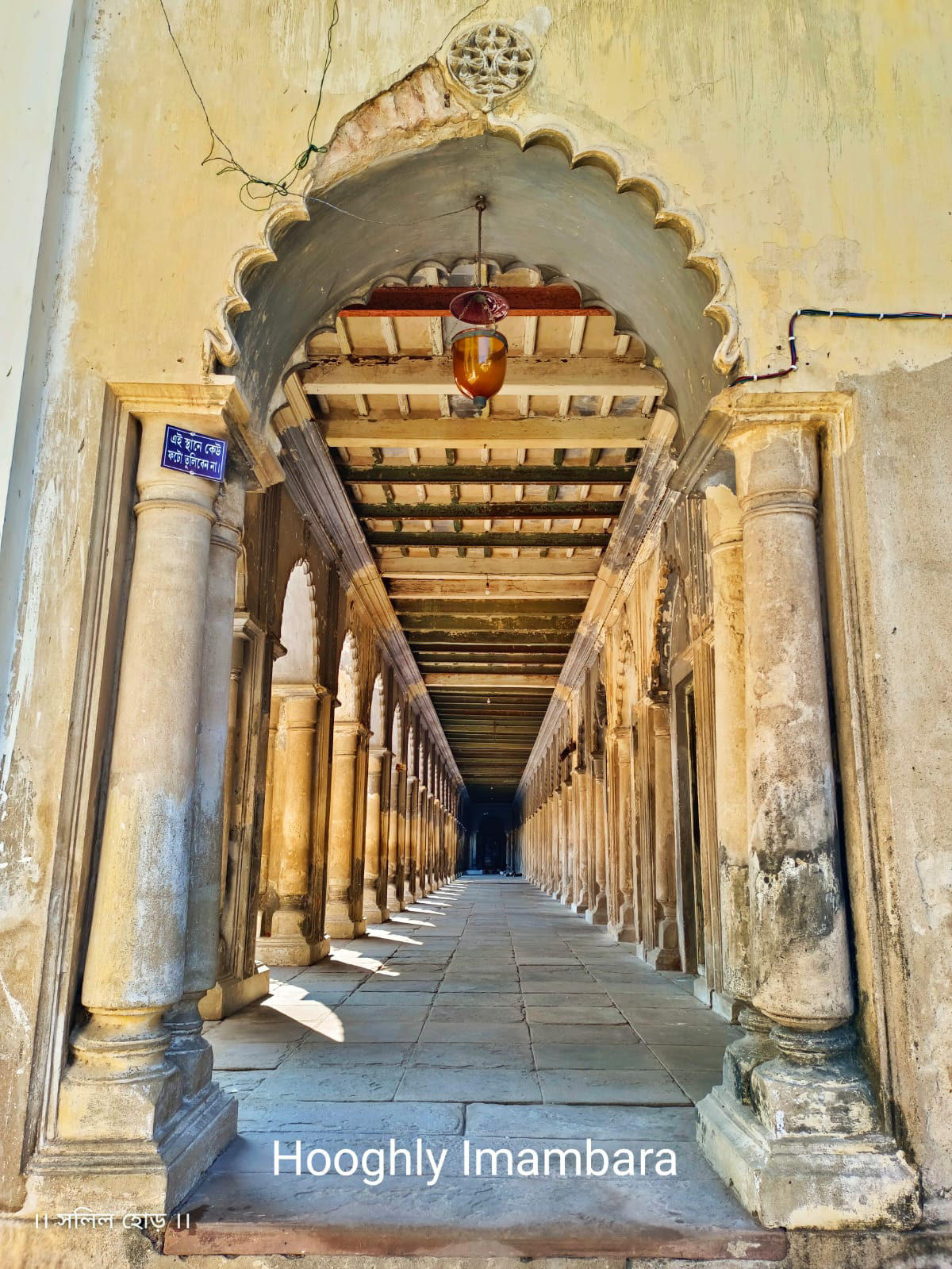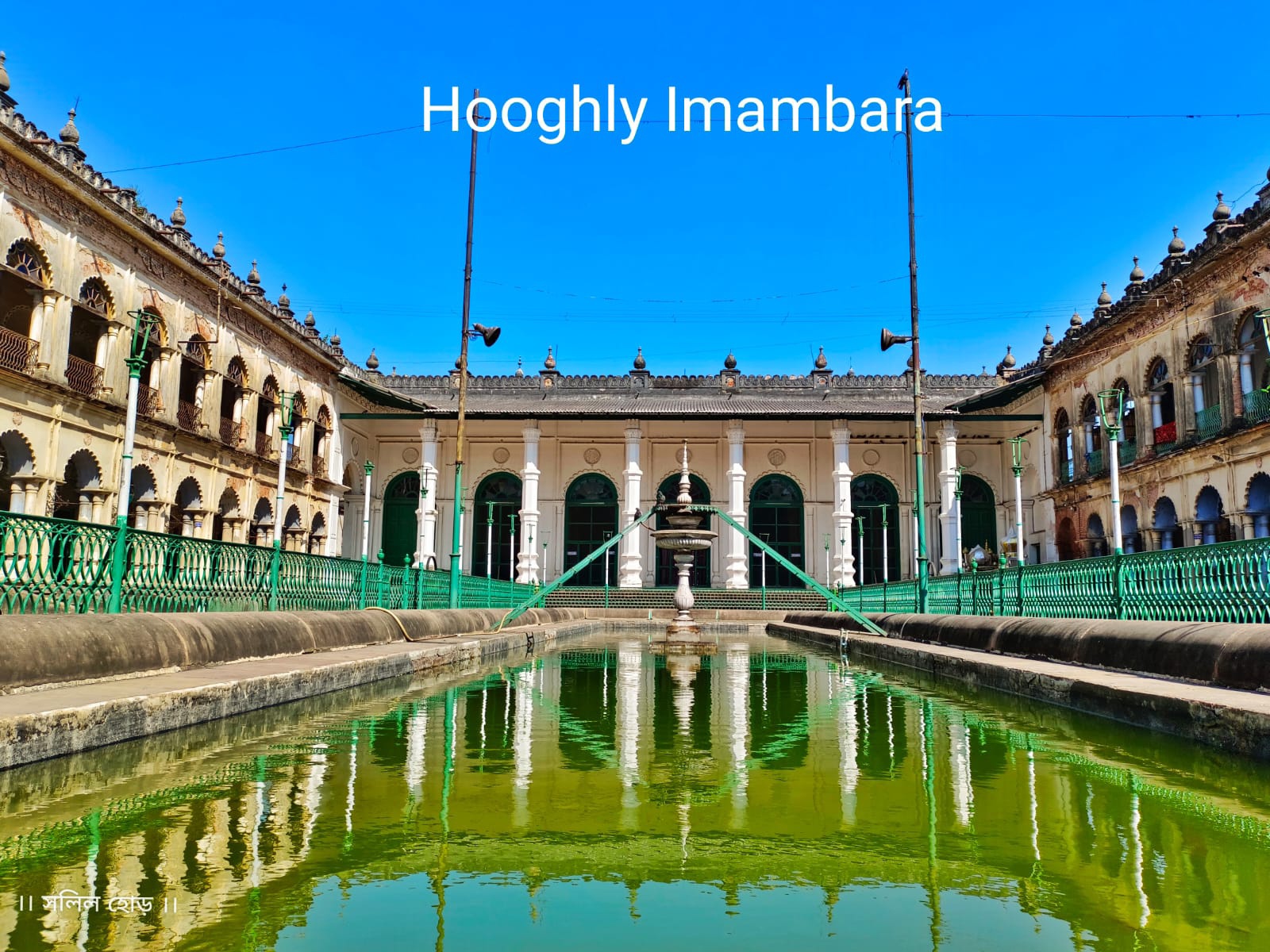হুগলি ইমামবাড়া, হুগলি জেলা (Hooghly Imambara, Hooghly District)
হুগলি জেলার মধ্যে দিয়ে বয়ে গেছে হুগলি নদী। এই প্রাচীন জেলায় কলোনি স্থাপন করেছিল ফ্রেঞ্চ, ড্যানিশ এবং পর্তুগিজরা। এখানে হুগলি স্টেশনের কাছে রয়েছে হাজি মহম্মদ মহসিনের তৈরি একটি বিরাট আকারের ইমামবাড়া, যার কথা সম্ভবত ভ্রমণপিপাসু মানুষমাত্রই জানেন। এর সাথে, এটি বিখ্যাত পৃথিবী বিখ্যাত একটি ঘড়ির জন্য। ইমামবাড়ার প্রবেশদ্বারের উপর রয়েছে একটি বড় চূড়া, যার উচ্চতা প্রায় ১৫০ ফুট,সেই চূড়ায় ওঠার জন্য দুইদিকে রয়েছে দুটি সিঁড়ি; আর চূড়ার মাঝ বরাবর অবস্থিত সেই বিস্ময়কর ঘড়ি।
লেখাটা শুরুর আগে, ইমামবাড়ার বিষয়ে একটু পরিষ্কার ধারণা দেওয়া দরকার। ইমামবাড়া শব্দের সোজাসুজি মানে হয়, ইমামের বাড়ি। কিন্তু ভারত উপমহাদেশে, ইমামবাড়া বলতে বোঝায় শিয়া-মুসলিমদের মিলনস্থল, যেখানে তারা জমা হয়ে নামাজ পড়তে পারেন এবং ধর্মীয় আচার পালন করতে পারেন। মসজিদের সাথে এখানেই ইমামবাড়ার তফাৎ; কারণ মসজিদে সবাই নামাজ পড়তে পারেন, আর ইমামবাড়া শুধু শিয়াদের জন্য।
এবার আসা যাক এই ইমামবাড়ার প্রতিষ্ঠার ইতিহাসের বিষয়ে। তবে তার আগে জানতে হবে ইরানিয়ান ব্যবসায়ীরা কিভাবে ভারতে নিজেদের বসতি স্থাপন করলো।
মুঘল সম্রাট ঔরঙ্গজেবের (Aurangzeb) সময় থেকেই ইরান, উজবেকিস্তান, আরব প্রভৃতি সুদূর দেশ থেকে ভারতে ব্যবসায়িক সূত্রে আসতে শুরু করে। এরা আরবী ঘোড়া বা মদের বিনিময়ে কিনে নিয়ে যেতো কাপড় এবং মশলা। কিন্তু এর সাথে তাদের একটা উদ্দেশ্য থাকতো সুলতানকে যে কোনো প্রকারে সন্তুষ্ট করে, এই দেশের বিভিন্ন অঞ্চলে জমি-জায়গা বাগিয়ে নেওয়া! এই সূত্রেই ইরানের ইস্পাহান শহর থেকে দিল্লিতে আসেন লবণ ব্যবসায়ী আগা মহম্মদ মোতাহার। ভারতে আসার কিছুদিনের মধ্যেই তিনি ঔরঙ্গজেবের সুনজরে পড়েন এবং হুগলি যশোর ইত্যাদি এলাকায় অনেক জমিজমা লাভ করেন। ১৭০০ খ্রিস্টাব্দ নাগাদ মোতাহার হুগলিতে আসেন নিজের তিন পত্নী এবং কর্মচারীদের সাথে। বাংলায় তার ব্যবসায় বেশ ফুলেফেঁপে ওঠে। আজকে যেখানে ইমামবাড়া, মোটামুটি সেখানেই ছিল তার একটি একতলা বাড়ি, যেটি তিনি ঈশ্বরের নামে উৎসর্গ করেন। পরবর্তীকালে তার জামাই মির্জা সালাউদ্দিন বাড়িটির লাগোয়া গড়ে তোলেন একটি তাজিয়াখানা, এবং প্রতিষ্ঠা হয় একটি ইমামবাড়ার। তবে বিভিন্ন তথ্যসূত্রে, এখানে আরও একটি ইমামবাড়ার উল্লেখ পাওয়া যায়, যার পাশেই মোতাহারের বাড়িটি ছিল। সেই পুরোনো ইমামবাড়ার প্রতিষ্ঠাতা হিসেবে মুর্শিদকুলি খাঁ এর নাম পাওয়া যায়, আবার পাওয়া যায় বিবি আনোয়ার নামের একজন ধনী মহিলার নাম। কিন্তু কোনো সঠিক তথ্য প্রমাণ না থাকায়, মোতাহার সেই পুরোনো ইমামবাড়ার সংস্কার করেছিলেন নাকি নতুন করে তৈরি করেছিলেন... সেটা জানা যায় না।
মোতাহারের সাথে কর্মসূত্রে পরিচয় হয় হাজী ফয়জুল্লা ইস্পাহানির সাথে, যিনি ব্যবসায়সূত্রে ইরান থেকে এসে মুর্শিদাবাদে থাকতেন। মোতাহারের সাথে ভালো সম্পর্ক গড়ে ওঠার ফলে, তিনি ইস্পাহানিকে নিজের ব্যবসায়ের এজেন্ট হিসেবে নিয়োগ করেন। কিন্তু এর মধ্যেই ৭৮ বছর বয়সে মোতাহার শেষ নিঃশ্বাস ত্যাগ করেন। তখন তার সম্পত্তির মালিক হন তৃতীয় পক্ষের স্ত্রী জায়নব খানমের মেয়ে মরিয়ম খানম (মন্নুজান) , যার বয়স মাত্র ৭ বছর। সম্পত্তি নিয়ে যাতে কোনো জটিলতা সৃষ্টি না হয়, সেই জন্য ইস্পাহানি হুগলিতে ফিরে এসে জায়নব খানমকে বিয়ে করেন এবং মরিয়মের সৎ পিতা হন। জায়নব খানমের গর্ভে ইস্পাহানির এক পুত্রসন্তান জন্মগ্রহণ করে, যার নাম আজকের আলোচ্য মহম্মদ মহসিন ইস্পাহানি।
দুজন আলাদা পিতার থেকে জন্মগ্রহণ করলেও, মন্নুজান এবং মহসিনের মধ্যে ছিল খুব ভালো সম্পর্ক। পরবর্তীকালে মন্নুজানের সাথে বিবাহ হয় হুগলির ফৌজদার মির্জা সালাউদ্দিনের সাথে। প্রসঙ্গত উল্লেখ্য, এই সালাউদ্দিনের নামেই পত্তন হয় 'মির্জা সালারের হাট', বর্তমানে যার নাম ইমামবাজার।
ছোটবেলা থেকে মহসিনের ছিল প্রবল বিদ্যানুরাগ। আগা সিরাজী নামের একজন শিক্ষক ও পরিব্রাজক ব্যক্তির কাছে তিনি পড়াশোনা শুরু করেন। কোরানের সাথে সাথে তিনি আরবী ও ফার্সি ভাষা শিখতে শুরু করেন। মুর্শিদাবাদেও তিনি কিছুদিন থেকেছিলেন উচ্চশিক্ষার জন্য। তারপর পিতার মৃত্যুর পরে, মহসিন বেরিয়ে পড়েন বিশ্বভ্রমণ করতে। বিপুল জমিদারির দায়িত্ব সামলাতে থাকেন মির্জা সালাউদ্দিন। আরব, তুরস্ক, মিশর ইত্যাদি দেশ ঘুরে শেষে আসেন তার পিতৃভূমি ইস্পাহানে, নিজের আত্মীয়দের কাছে। প্রায় দীর্ঘ ২৭ বছর পরে, ৬০ বছর বয়সে তিনি ভারতে ফেরেন।
সারা জীবনে মহসিন বিশ্বের সমস্ত মুসলিম দেশে গিয়েছিলেন এবং সেখানে বিদ্যাচর্চা করেছিলেন। এর ফলে তার সন্মান এবং জ্ঞানের পরিধি তৎকালীন সমাজে অনেকটা বেড়ে গিয়েছিল। বিভিন্ন ভাষার শিক্ষা বাদেও তিনি পার্সি ও আরবি ভাষার ক্যালিগ্রাফি আয়ত্ত করেছিলেন। নিজের হাতে করা কোরানের অনুলিপিগুলো তিনি গরীব মানুষদের মধ্যে বিলি করতেন, যাদের অর্থমূল্য ছিলো অনেক।
ইতিমধ্যে মির্জা সালাউদ্দিনের মৃত্যু হয়েছে, এবং মন্নুজান জমিদারির দায়িত্ব কাঁধে তুলে দিয়েছেন। মহসিন ভারতে ফিরে এসেছেন জানতে পেরে তাকে মন্নুজান হুগলিতে ফিরিয়ে আনেন। এরপর ১৮০৩ খ্রিষ্টাব্দে মন্নুজানের মৃত্যু হলে, ৭৩ বছর বয়সে হাজী মহম্মদ মহসিন এই বিরাট সম্পত্তির অধিকারী হন। কিন্তু সম্পত্তির অধিকারী হয়েও তার পরোপকার এবং দান-ধ্যান করার কোনো খামতি ঘটে না, বরং সেটা আরো বৃদ্ধি পায়। ১৮০৬ খ্রিষ্টাব্দে তিনি একটা 'ওয়াকফ ডিড' তৈরি করেন, যার তৎকালীন অর্থমূল্য হয় ১,৫৬,০০০/-। সেই ট্রাস্টের মাধ্যমেই জমিদারি পরিচালনা করতে থাকেন মহসিন। ট্রাস্টের ফান্ড থেকেই পরবর্তীকালে হুগলির মহসিন কলেজ, ইমামবাড়া হাসপাতাল ইত্যাদি অনেক জনহিতকর কর্মসূচি নেওয়া হয়েছিল। বাংলাদেশেও তৈরি করা হয়েছিল অনেক স্কুল, কলেজ, মাদ্রাসা এবং ইমামবাড়া।
মহসিন আর বেশিদিন বাঁচেন নি। ১৮১২ খ্রিষ্টাব্দে, ৮০ বছর বয়সে তিনি শেষ নিঃশ্বাস ত্যাগ করেন। বর্তমান ইমামবাড়ার পূর্বদিকে, বাগানের মধ্যে ছিল ইস্পাহানি পরিবারের সমাধিক্ষেত্র। সেখানেই মহসিনকে সমাধি দেওয়া হয়, অন্যান্য পরিবারের সদস্যদের সাথে।
ওয়াকফ ডিড অনুযায়ী সবকিছু পরিচালনার জন্য মহসিন একজন মোতাওয়াল্লিকে নিযুক্ত করেছিলেন। কিন্তু মহসিনের মৃত্যুর পর ১৮১৫ খ্রিষ্টাব্দে তার বিরুদ্ধে তহবিল তছরুপের অভিযোগ ওঠে। বিষয়টার অর্থমূল্য এবং জটিলতা এতটাই বেশি ছিল, যে তৎকালীন ব্রিটিশ সরকারকে এই বিষয়ে হস্তক্ষেপ করতে হয়। শেষে ১৮৩৭ খ্রিষ্টাব্দে আদালতের আদেশে, নতুন মোতাওয়াল্লি নিযুক্ত হন রাজস্থানের জৌনপুরের আদি বাসিন্দা, মৌলবী সৈয়দ কেরামত আলী। তারই তত্ত্বাবধানে গড়ে ওঠে আজকের এই বৃহৎ ইমামবাড়া। ১৮৪৫ থেকে ১৮৬১ খ্রিষ্টাব্দ পর্যন্ত নির্মাণকাজ চলেছিল, এবং খরচ হয়েছিল প্রায় দুই লক্ষ টাকা।
এবার আসা যাক ইমামবাড়ার বর্ণনায়। একটা বিরাট ফটক পেরিয়ে প্রবেশ করতে হয় ইমামবাড়া প্রাঙ্গণে। প্রবেশপথের মুখেই রয়েছে দুদিকে দুটো ঘর, একটা তাজিয়াখানা (যেখান থেকে মহরমের সময় তাজিয়া সাজিয়ে বের করা হয়) এবং অন্যটি সরবতখানা (এখানে একটি বড় চৌবাচ্চার মধ্যে শরবত বানিয়ে মহরমের সময় বিলি করা হয়)। প্রাঙ্গণের দুইপাশে আছে টানা বারান্দাযুক্ত দোতলা ভবন, যেগুলো আগে মাদ্রাসা হিসেবে ব্যবহার হতো। উঠোনের ঠিক মাঝেই আছে একটা বিরাট আয়তকার উঁচু জলাধার, যার মাঝে রয়েছে একটি সুরম্য ফোয়ারা। আগে ফোয়ারাটি চালু ছিল এবং জলাধারের মধ্যে অনেক রঙিন মাছ ছিল। বর্তমানে সেগুলো নেই, শুধু আছে জল আর শেওলা।
জলাধারটি পেরিয়ে সামনের দিকে গেলে একটা উঁচু ভিত্তির ওপরে রয়েছে কারুকার্যময় বিরাট একটি প্রার্থনা কক্ষ, যা দাঁড়িয়ে আছে ছয়টি স্তম্ভের অপরে এবং রয়েছে সাতটি প্রবেশদ্বার। তবে মূলত যেটা দেখে চোখ জুড়িয়ে যায়, সেটা হলো দেওয়াল জুড়ে ফার্সি ক্যালিগ্রাফি; যেগুলো 'হাদিস' থেকে নেওয়া পবিত্র ইসলামের বাণী।
ছাদের থেকে ঝোলানো আছে বেলজিয়াম কাঁচের লণ্ঠন ও ঝাড়বাতি, এবং মেঝেতে রয়েছে সাদা কালো মার্বেলের নকশা। প্রার্থনাকক্ষটি দুই ভাগে বিভক্ত। প্রথম ভাগটিতে সাধারণ দর্শনার্থীরা ঢুকতে পারেন, আর পরের ভাগটি একটা রেলিং দিয়ে প্রথম ভাগ থেকে বিভক্ত। দ্বিতীয় ভাগে রয়েছে কয়েকটি সুসজ্জিত তাজিয়া। প্রার্থনাকক্ষে দরজাগুলোতে রয়েছে রঙিন কাঁচের নকশা। প্রার্থনাকক্ষের বাইরের দেওয়ালে মহসিনের সেই ওয়াকফ ডিডটি খোদাই করে রাখা আছে।
এই কক্ষের পিছনেই বয়ে যাচ্ছে হুগলি নদী। তাই নদীর ওপরে রয়েছে একটা ঘাট। এই ঘাটে আছে প্রায় তিন ফুট উঁচু সিমেন্টের তৈরি একটা সূর্যঘড়ি। এর কাঁটাটি আগে পিতলের ছিল, কিন্তু সেটা চুরি হয়ে যাবার পর এখন সিমেন্ট দিয়েই বানানো হয়েছে। তবে এতে সময়টা পুরোপুরি নিখুঁত দেখায় না।
এবার আসা যাক ইমামবাড়ার মূল আকর্ষণ, ঘড়ি গম্বুজ (Clock Tower)। ইমামবাড়া প্রবেশদ্বারের উপর একটি চূড়া আছে, যার উচ্চতা আনুমানিক ১৫০ ফুট। চূড়াটিতে উঠবার জন্য দুই দিক থেকে দুইটি সিঁড়ি আছে। এই চূড়ার মাঝখানে একটি বিস্ময়কর ঘড়ি লাগানো আছে। মীর কেরামত আলি ১১,৭২১ টাকা দিয়ে ঘড়িটি ইংল্যান্ড থেকে কিনেছিলেন। ঘড়িটিতে সপ্তাহে একদিন দম দিতে হয়। দম দিতে কমপক্ষে দুইজন লোকের প্রয়োজন হয়। দম দেওয়ার জন্য যে চাবিটি ব্যবহৃত হয়, তার ওজন প্রায় ২০ কিলোগ্রাম। চূড়ার দুদিকে দুটি ডায়াল আছে এবং ডায়াল দুটিতে ওই সংযুক্ত কাঁটা গুলি একটিই মেশিন দ্বারা চালিত ঘড়িটিতে শুধু সময় জানায় না, নির্দিষ্ট সময় অন্তর ঘন্টার আওয়াজ শোনা যায়। মেশিন ঘরের ঠিক ওপরে তিনটি কয়েক কুইন্টাল ওজনের তিন আকারের ঘন্টা আছে। যার ওজন যথাক্রমে ৮০মন, ৪০ মন ও ৩০ মন। মাঝারি ও ছোট ঘন্টাদ্বয় প্রতি ১৫ মিনিট অন্তর বাজে এবং বড় ঘন্টাটি প্রতি এক ঘন্টা অন্তর বাজে। এই ঘড়িটির কাঁটা আজও নিয়মিত চলছে ও তার কাজ, যথাযথ পালন করে চলেছে।
প্রায় ১৫২ টা সিঁড়ি বেয়ে ঘণ্টার চূড়ায় উঠলে ইমামবাড়া, নদী এবং জুবিলি ব্রিজের একটা পাখির চোখের ছবি (Birds Eye View) পাওয়া যায়। সাথে নদীর দিক থেকে ভেসে আসা মনোরম সিঁড়ি চড়ার সমস্ত শ্রান্তি দূর করে দেয়।
বর্তমানে ইমামবাড়ার কিছুটা সংস্কার হলেও, এখনো অনেক সংস্কার প্রয়োজন। কিছুদিন আগে একটা নতুন শৌচালয় বানানো হয়েছে, যেটার খুব প্রয়োজন ছিল। একটা বিষয় খারাপ লাগলো যে, সিঁড়ির দেওয়ালে বিভিন্ন ঐতিহাসিক স্থানের মতো এখানেও প্রেম নিবেদনের বন্যা বয়ে গেছে। কিছু কম বয়সী ছেলে মেয়েদের অশালীন আচরণ লক্ষ্য করলাম লম্বা বারান্দার আড়ালে। সত্যি বলতে এতো বড়ো ইমামবাড়া নজরদারি করতে যে পরিমাণ প্রহরী দরকার, তার অতি সামান্য রয়েছে এখানে।
প্রতিদিন সকাল ৮ টা থেকে বিকেল ৫ টা/ ৬ টা পর্যন্ত খোলা থাকে এই ইমামবাড়া। নির্দিষ্ট প্রবেশমূল্য দিয়ে ঘুরে আসতে পারেন যে কোনো দিন। সাথে গঙ্গাবক্ষে নদীবিহারও করতে পারেন ছোট ছোট দাঁড়টানা নৌকাতে।
তথ্য সূত্র:
A Sketch of the Administration of the Hooghly District from 1795 to 1845, With Some Account of the Early English, Portuguese, Dutch, French and Danish Settlements – George Toynbee
Hooghly : Past and Present by Shambhoo Chunder Dey
History of Bengal, Vol II Muslim Period, 1200-1757- Sir Jadunath Sarkar
The Muslim Heritage of Bengal by Md. Mojlum khan
Twelve men of Bengal in the nineteenth century by Bradley – Birt, F.B.
Collection of papers relating to the Hooghly Imambarah, 1815-1910 by Bengal; Bengal. Board of Revenue
The land of ind by James Kerr
The Modern History of the Indian Chiefs, Rajas, Zamindars, & C: The native aristocracy and gentry – Lokenath Ghose
An Earthly Paradise: Trade, Politics and Culture in Early Modern Bengal – edited by Raziuddin Aquil, Tilottama Mukherjee
হুগলি জেলার ইতিহাস ও বঙ্গ সমাজ (দ্বিতীয় খণ্ড) - সুধীরকুমার মিত্র
*******************************
The Hooghly River meanders through the district of Hooghly, a historical land where the French, Danish, and Portuguese once established their colonies. Near the Hooghly station stands a grand Imambara, built by Haji Muhammad Mohsin, a name familiar to most travel enthusiasts. This Imambara is particularly renowned for its world-famous clock. Above the entrance gate, a towering minaret, approximately 150 feet high, features two staircases ascending to its summit, where this remarkable clock is centrally located.
Before delving further, it's essential to understand the significance of an Imambara. Literally translating to "the house of the Imam," in the Indian subcontinent, an Imambara signifies a congregation hall for Shia Muslims, serving as a place for prayer and religious observances. This distinguishes it from a mosque, which is open to all Muslims, while an Imambara is specifically for the Shia community.
Now, let's explore the history of this Imambara's establishment, but first, we must understand how Iranian merchants settled in India.
From the reign of the Mughal Emperor Aurangzeb onwards, traders from distant lands like Iran, Uzbekistan, and Arabia began arriving in India for commercial purposes. They traded Arabian horses and wine for textiles and spices. However, their underlying motive was to gain favor with the Sultan and acquire land in various regions of the country. Following this trend, Agha Muhammad Motahar, a salt merchant from Isfahan, Iran, came to Delhi. Within a short period, he gained Aurangzeb's favor and acquired significant land holdings in areas like Hooghly and Jessore. Around 1700 AD, Motahar settled in Hooghly with his three wives and employees. His business flourished in Bengal. The present site of the Imambara was roughly where his single-storied house stood, which he dedicated in the name of God. Later, his son-in-law, Mirza Salauddin, built a Taziakhana adjacent to the house, thus establishing an Imambara. However, various historical sources mention another Imambara in the vicinity of Motahar's house. Some attribute its founding to Murshid Quli Khan, while others name Bibi Anwar, a wealthy woman. Without definitive evidence, it remains unclear whether Motahar renovated the older Imambara or built a new one.
Through his business dealings, Motahar became acquainted with Haji Faizullah Isfahani, a merchant from Iran residing in Murshidabad. Their good relationship led Motahar to appoint Isfahani as his business agent. However, at the age of 78, Motahar passed away. His property then fell to Mariam Khanam (Mannujan), the seven-year-old daughter of his third wife, Zainab Khanam. To avoid any property disputes, Isfahani returned to Hooghly, married Zainab Khanam, and became Mariam's stepfather. Isfahani and Zainab Khanam had a son together, who is the subject of our discussion today: Muhammad Mohsin Isfahani.
Despite having different fathers, Mannujan and Mohsin shared a close bond. Mannujan later married Mirza Salauddin, the Faujdar (military governor) of Hooghly. It is worth noting that the marketplace 'Mirza Salar's Haat', now known as Imambazar, was named after this Salauddin.
From a young age, Mohsin displayed a strong inclination towards learning. He began his education under Agha Shirazi, a teacher and traveler. Along with the Quran, he started learning Arabic and Persian. He also resided in Murshidabad for some time for higher education. After his father's death, Mohsin embarked on extensive travels around the world. Mirza Salauddin took charge of managing the vast estate. After visiting countries like Arabia, Turkey, and Egypt, Mohsin finally returned to his ancestral home in Isfahan to be with his relatives. He returned to India at the age of 60, after nearly 27 years.
Throughout his life, Mohsin traveled to various Muslim countries, pursuing knowledge and learning. As a result, his respect and wisdom grew significantly in contemporary society. Besides mastering several languages, he also excelled in Persian and Arabic calligraphy. He would distribute handwritten copies of the Quran, which were of considerable value, among the poor.
Meanwhile, Mirza Salauddin had passed away, and Mannujan had taken over the responsibility of the estate. Upon learning of Mohsin's return to India, Mannujan brought him back to Hooghly. Following Mannujan's death in 1803, at the age of 73, Haji Muhammad Mohsin inherited this vast property. However, acquiring the estate did not diminish his philanthropic activities; rather, they increased. In 1806, he created a 'Waqf Deed' (an irrevocable charitable endowment) with a contemporary value of ₹1,56,000. Mohsin continued to manage the estate through this trust. The trust's funds were later used for numerous public welfare initiatives, including the establishment of Mohsin College and the Imambara Hospital in Hooghly. Many schools, colleges, madrasas, and Imambaras were also built in Bangladesh.
Mohsin did not live much longer. He passed away in 1812 at the age of 80. The Isfahani family's burial ground was located in the garden to the east of the present Imambara. Mohsin was laid to rest there alongside other family members.
In accordance with the Waqf Deed, Mohsin had appointed a Mutawalli (trustee) to manage the affairs. However, after Mohsin's death, in 1815, allegations of fund embezzlement were raised against him. The financial magnitude and complexity of the matter were so significant that the British government of the time had to intervene. Finally, in 1837, by court order, a new Mutawalli was appointed: Maulvi Syed Keramat Ali, originally from Jaunpur in Rajasthan. Under his supervision, the grand Imambara as it stands today was built. Construction took place from 1845 to 1861, incurring a cost of approximately two hundred thousand rupees.
Now, let's describe the Imambara itself. Entering the Imambara complex through a large gate, one encounters two rooms at the entrance. One is the Taziakhana (from where the Tazia processions are organized during Muharram), and the other is the Sharbatkhana (where Sharbat, a sweet drink, is prepared in a large reservoir and distributed during Muharram). On either side of the courtyard are two-storied buildings with continuous verandas, which were previously used as madrasas. In the center of the courtyard is a large rectangular elevated water reservoir with a beautiful fountain in the middle. The fountain was once operational, and the reservoir contained many colorful fish. Currently, it only holds water and algae.
Crossing the reservoir, one reaches a magnificent, intricately decorated prayer hall situated on a raised platform, supported by six pillars and featuring seven entrances. However, what truly captivates the eye are the Persian calligraphic inscriptions adorning the walls, which are sacred Islamic verses taken from the 'Hadith'.
Belgian glass lanterns and chandeliers hang from the ceiling, and the floor is patterned with black and white marble. The prayer hall is divided into two sections. The first section is accessible to general visitors, while the second is separated by a railing. The second section houses several well-decorated Tazias. The doors of the prayer hall feature colorful glass designs. On the outer wall of the prayer hall, Mohsin's Waqf Deed is inscribed.
Behind this hall flows the Hooghly River. Consequently, there is a ghat (steps leading to the river) on the riverbank. At this ghat stands a sundial made of cement, approximately three feet high. Its gnomon (indicator) was originally made of brass but was stolen and has since been replaced with cement. However, it does not provide perfectly accurate time.
Now we come to the main attraction of the Imambara: the Clock Tower. Above the entrance gate of the Imambara is a minaret, approximately 150 feet in height. Two staircases ascend from either side to the top of this minaret. In the middle of the minaret is a remarkable clock. Mir Keramat Ali purchased this clock from England for ₹11,721. The clock needs to be wound once a week, a task requiring at least two people. The key used for winding weighs about 20 kilograms. There are two dials on either side of the minaret, and the connected hands on both dials are driven by a single machine. The clock not only shows the time but also chimes at regular intervals. Just above the machine room are three bells of different sizes, weighing several quintals each, specifically 80, 40, and 30 maunds (an old Indian unit of weight). The medium and small bells chime every 15 minutes, and the large bell chimes every hour. The hands of this clock continue to move regularly, performing their duty faithfully even today.
Climbing approximately 152 steps to the top of the clock tower provides a bird's-eye view of the Imambara, the river, and the Jubilee Bridge. The pleasant breeze from the river refreshes one, dispelling any fatigue from the climb.
While some renovations have been carried out at the Imambara recently, much more is still needed. A new toilet block has been constructed, which was much required. A disappointing aspect is the presence of love inscriptions on the staircase walls, similar to those found at various historical sites. Behind the long verandas, I also observed some inappropriate behavior by young couples. Frankly, the number of guards present is minimal compared to what is needed to oversee such a large Imambara.
The Imambara is open daily from 8 am to 5/6 pm. Visitors can explore the site on any day by paying a nominal entrance fee. Additionally, one can enjoy a boat ride on the Ganges in small rowing boats.
Source of Information:
* A Sketch of the Administration of the Hooghly District from 1795 to 1845, With Some Account of the Early English, Portuguese, Dutch, French and Danish Settlements – George Toynbee
* Hooghly : Past and Present by Shambhoo Chunder Dey
* History of Bengal, Vol II Muslim Period, 1200-1757- Sir Jadunath Sarkar
* The Muslim Heritage of Bengal by Md. Mojlum khan
* Twelve men of Bengal in the nineteenth century by Bradley – Birt, F.B.
* Collection of papers relating to the Hooghly Imambarah, 1815-1910 by Bengal; Bengal. Board of Revenue
* The land of ind by James Kerr
* The Modern History of the Indian Chiefs, Rajas, Zamindars, & C: The native aristocracy and gentry – Lokenath Ghose
* An Earthly Paradise: Trade, Politics and Culture in Early Modern Bengal – edited by Raziuddin Aquil, Tilottama Mukherjee
* হুগলি জেলার ইতিহাস ও বঙ্গ সমাজ (দ্বিতীয় খণ্ড) - সুধীরকুমার মিত্র






















Comments
Post a Comment